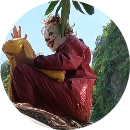Look at the picture:

Những câu hỏi liên quan
Work in pairs. Ask and answer about the things you and your friends do on Earth Day.
Example:
A: What do you do on Earth Day?
B: We pick up litter and clean the streets. And you?
A: ...

A: What do you do on Earth Day?
(Các bạn làm gì vào ngày Trái Đất?)
B: We plant trees and flowers along the neighbour’s streets. And you?
(Chúng tôi trồng cây và hoa dọc theo những con đường nơi chúng tôi sống. Còn mọi người thì sao?)
A: We join a team to clean up the trash on the street and we hang up some bee houses.
(Chúng tôi tham gia một đội dọn rác trên đường phố và chúng tôi xây một vài tổ ong.)
Đúng 0
Bình luận (0)
Read the fact sheet. What happens to water when it falls to the Earth? THE WATER CYCLENow here is a challenge for you. Go and get a glass of water and take a look at it. Can you guess how old it is? Well, your water perhaps fell from a cloud just a couple of weeks ago, but it has been around for the same length of time as planet Earth! That means that your glass of water was around when the first creatures swam in the sea and when the dinosaur...
Đọc tiếp
Read the fact sheet. What happens to water when it falls to the Earth?
THE WATER CYCLE
Now here is a challenge for you. Go and get a glass of water and take a look at it. Can you guess how old it is? Well, your water perhaps fell from a cloud just a couple of weeks ago, but it has been around for the same length of time as planet Earth! That means that your glass of water was around when the first creatures swam in the sea and when the dinosaurs roamed the Earth. But how is this possible?
The fact is that the quantity of water on the Earth remains the same over time and it constantly goes through the water cycle. In the cycle, there is continuous movement of water on, above and below the surface of the Earth. Firstly, the sun heats the water in the rivers, seas and oceans, and it evaporates into the air. Plants and trees lose water, too, and this also goes up into the air. The water vapour then cools and condenses into small drops which form clouds. You can see how condensation happens if you look again at your glass of water on a hot day. After a short time, water from the air condenses onto the cold glass. Back to the sky, though, and the next step is that the clouds gradually get heavier and heavier until they can’t hold the water any more, and it falls to Earth as rain, sleet or snow.
Water can change state from liquid to vapour to solid during the cycle, but any form of water that falls from the clouds is called precipitation. When on Earth, some of the water runs into rivers, lakes and streams and becomes surface water. Some enters the ground and forms underground rivers or lakes before eventually flowing back to the seas and oceans. The cycle is complete.
When falling to the Earth, some of the water runs into rivers, lakes and streams and becomes surface water. Some enters the ground and forms underground rivers or lakes.
Đúng 0
Bình luận (0)
Read the text and answer the following questions.The Earth was formed about 4.7 billion years ago. The Earths shape is very close to that of a sphere, not perfectly spherical. The Earths equatorial diameter is about 12,756 km, which is slightly larger than the polar diameter; about 12,714 km Surface Area of the Earth is 510,065,600 km2 of which 148,939,100 km2 (29.2%) is land and 361,126,400 km2 (70.8 %) is water. The Earth rotates on its axis, an imaginary straight line through its centre. The...
Đọc tiếp
Read the text and answer the following questions.
The Earth was formed about 4.7 billion years ago. The Earth's shape is very close to that of a sphere, not perfectly spherical. The Earth's equatorial diameter is about 12,756 km, which is slightly larger than the polar diameter; about 12,714 km Surface Area of the Earth is 510,065,600 km2 of which 148,939,100 km2 (29.2%) is land and 361,126,400 km2 (70.8 %) is water. The Earth rotates on its axis, an imaginary straight line through its centre. The two points where the axis of rotation intersects the Earth's surface are called as the poles, one of them is called the North Pole and the other is known as the South Pole. One rotation with respect to Sun is completed in 24 hours, called a solar day.
1. When was the Earth created?
2. How is the Earth?
3. What main elements does the Earth include?
4. What are the places of the axis of rotation intersects the Earth‟s surface called?
5. How long is a solar day completed?
1. It was created about 4.7 billion years ago.
2. Its shape is very close to that of a sphere, not perfectly spherical.
3. They are land and water.
4. They are the North Pole and the South Pole.
5. It's in 24 hours.
1. the Earth was created 4.7 billions years ago.
2. the Earth is very close to that of a sphere, not perfectly spherical.
3. the Earth includes 148,939,100 km2 (29.2 %) is land and 361,126,400 km2 (70.8 %) is water.
4. the places of...surface are called as the poles, one of them is called the North Pole and the other is known as the South Pole.
5. a solar day is completed in 24 hours
1 It was created about 4.7 billion years ago.
2 Its shape is very close to that of a sphere, not perfectly spherical.
3 They are land and water.
4 They are the North Pole and the South Pole.
5 It's in 24 hours.
Xem thêm câu trả lời
Tìm lỗi sai trong đoạn văn sau
future home is an exhibition of where we will live in the future and what our homes will be like, and it is coming to the museum of mankind on this september. the organizers say there are going to be hundreds of interesting house models and there will to be plenty of fantastic things for all age groups. One of the most exciting things to see will be the model of the space hotel, designed by the Shimuzu Corporation of Japan. As soon as space travel become cheaper...
Đọc tiếp
Tìm lỗi sai trong đoạn văn sau
future home is an exhibition of where we will live in the future and what our homes will be like, and it is coming to the museum of mankind on this september. the organizers say there are going to be hundreds of interesting house models and there will to be plenty of fantastic things for all age groups. One of the most exciting things to see will be the model of the space hotel, designed by the Shimuzu Corporation of Japan. As soon as space travel become cheaper, the hotel will be built about 90 km above Earth. The hotel itself will have their own air supply and food will be flown up to there from Earth on space shuttles. There will be a total of 64 guest rooms. At last, tourism themselves will be able to enjoy looking down on Earth from space
Chia động từ1 She asked me What I (do) .................... the following day2 Mai said that the moon (go).................. around the Earth and the Earth (move)............... around the sun3 Mai told Nam ( not talk)................................. in the class4 Ba told me he (be)...................................................tired5 Peter asked me where I (live)..............................6 He (not see).................................................................... his brother rece...
Đọc tiếp
Chia động từ
1 She asked me What I (do) .................... the following day
2 Mai said that the moon (go).................. around the Earth and the Earth (move)............... around the sun
3 Mai told Nam ( not talk)................................. in the class
4 Ba told me he (be)...................................................tired
5 Peter asked me where I (live)..............................
6 He (not see).................................................................... his brother recently
7 The "Ao dai" (mention) ............................ in poems and songs for centuries
8 My car (not repair ). ......................................... yet
9 My parents (not go ) .........................................out since they (have)...................a new pet
10 Miss Lan (speak)..........................................English when she (be)................. at school?
Đọc đoạn văn và trả lời câu hỏi
The Earth was formed about 4.7 billion years ago. The Earth’s shape is very close to that of a sphere, not perfectly spherical. The Earth’s equatorial diameter is about 12,756 km, which is slightly larger than the polar diameter; about 12,714 km Surface Area of the Earth is 510,065,600 km2 of which 148,939,100 km2 (29.2 %) is land and 361,126,400 km2 (70.8 %) is water.
The Earth rotates on its axis, an imaginary straight line through its centre. The two points w...
Đọc tiếp
Đọc đoạn văn và trả lời câu hỏi
The Earth was formed about 4.7 billion years ago. The Earth’s shape is very close to that of a sphere, not perfectly spherical. The Earth’s equatorial diameter is about 12,756 km, which is slightly larger than the polar diameter; about 12,714 km Surface Area of the Earth is 510,065,600 km2 of which 148,939,100 km2 (29.2 %) is land and 361,126,400 km2 (70.8 %) is water.
The Earth rotates on its axis, an imaginary straight line through its centre. The two points where the axis of rotation intersects the Earth’s surface are called as the poles, one of them is called the North Pole and the other is known as the South Pole. One rotation with respect to Sun is completed in 24 hours, called a solar day
1. When was the Earth created ?
-->
2. How is the Earth ?
-->
3 What main elements does the Earth include ?
-->
4. What are the places of the axis of rotation intersects the Earth's surface called?
-->
5. How long is a solar day completed?
-->
1. When was the Earth created ?
--> the Earth was created 4.7 billions years ago.
2. How is the Earth ?
--> the Earth is very close to that of a sphere, not perfectly spherical.
3 What main elements does the Earth include ?
--> the Earth includes 148,939,100 km2 (29.2 %) is land and 361,126,400 km2 (70.8 %) is water.
4. What are the places of the axis of rotation intersects the Earth's surface called?
--> the places of...surface are called as the poles, one of them is called the North Pole and the other is known as the South Pole.
5. How long is a solar day completed?
--> a solar day is completed in 24 hours
Đúng 0
Bình luận (0)
Part of the Earth which includes the living and non-living things. *
BIOTOPE
BIOMES
BIOSPHERE
ECOSPHERE
Choose the BIOCENOSIS. *
Temperature
Soil
Wind
Microorganisms
Work in pairs. Look at the picture and answer the questions.

1. What can you see in the picture?
2. When do we need these things?
1. I can see an emergency kit.
2. We need these things when it has a natural disaster.
Đúng 0
Bình luận (0)
What is the between the sky and earth???
Xem thêm câu trả lời





















